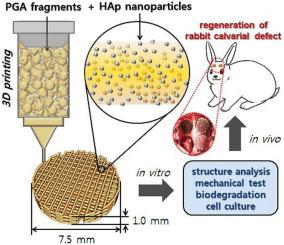当前位置:
X-MOL 学术
›
J. Ind. Eng. Chem.
›
论文详情
Our official English website, www.x-mol.net, welcomes your
feedback! (Note: you will need to create a separate account there.)
Promoting bone regeneration by 3D-printed poly(glycolic acid)/hydroxyapatite composite scaffolds
Journal of Industrial and Engineering Chemistry ( IF 5.9 ) Pub Date : 2021-02-01 , DOI: 10.1016/j.jiec.2020.11.004 Taegyun Yeo , Young-Gwang Ko , Eun Jin Kim , Oh Kyoung Kwon , Ho Yun Chung , Oh Hyeong Kwon
Journal of Industrial and Engineering Chemistry ( IF 5.9 ) Pub Date : 2021-02-01 , DOI: 10.1016/j.jiec.2020.11.004 Taegyun Yeo , Young-Gwang Ko , Eun Jin Kim , Oh Kyoung Kwon , Ho Yun Chung , Oh Hyeong Kwon

|
Abstract Hydroxyapatite (HAp) is a major bone graft component for hard tissue regeneration. However, sintered HAp has poor formability and mechanical properties. Porous 3D scaffolds for bone tissue regeneration were printed with computer-aided modeling using poly(glycolic acid) (PGA) and HAp. PGA scaffolds containing HAp nanoparticles were fabricated with a 400 μm pore size. PGA/HAp scaffolds containing 12.5 wt% HAp showed considerable compressive strength, osteogenesis, mineralization, and biodegradation. In in vivo animal experiments, the PGA/HAp group exhibited 47% bone regeneration, with superior bone mineral density 8 weeks after surgery. 3D-printed PGA/HAp scaffolds could provide a feasible option to promote patient-specific bone regeneration.
中文翻译:

通过 3D 打印聚(乙醇酸)/羟基磷灰石复合支架促进骨再生
摘要 羟基磷灰石(HAp)是硬组织再生的主要骨移植成分。然而,烧结HAp具有较差的可成形性和机械性能。用于骨组织再生的多孔 3D 支架使用聚(乙醇酸)(PGA)和 HAp 通过计算机辅助建模打印。含有 HAp 纳米粒子的 PGA 支架被制造为具有 400 μm 的孔径。含有 12.5% HAp 的 PGA/HAp 支架显示出相当大的抗压强度、成骨、矿化和生物降解。在体内动物实验中,PGA/HAp 组在手术后 8 周表现出 47% 的骨再生率和优越的骨密度。3D 打印的 PGA/HAp 支架可以提供一种可行的选择来促进患者特定的骨再生。
更新日期:2021-02-01
中文翻译:

通过 3D 打印聚(乙醇酸)/羟基磷灰石复合支架促进骨再生
摘要 羟基磷灰石(HAp)是硬组织再生的主要骨移植成分。然而,烧结HAp具有较差的可成形性和机械性能。用于骨组织再生的多孔 3D 支架使用聚(乙醇酸)(PGA)和 HAp 通过计算机辅助建模打印。含有 HAp 纳米粒子的 PGA 支架被制造为具有 400 μm 的孔径。含有 12.5% HAp 的 PGA/HAp 支架显示出相当大的抗压强度、成骨、矿化和生物降解。在体内动物实验中,PGA/HAp 组在手术后 8 周表现出 47% 的骨再生率和优越的骨密度。3D 打印的 PGA/HAp 支架可以提供一种可行的选择来促进患者特定的骨再生。











































 京公网安备 11010802027423号
京公网安备 11010802027423号